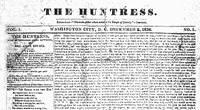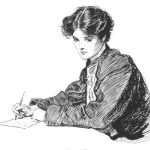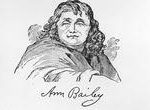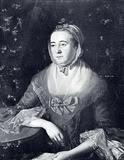First American Newspaperwoman
Anne Royall (1769-1854) was a professional journalist, travel writer and the first newspaperwoman in the United States. At the age of 62, Royall published her own newspapers, Paul Pry (1831-1836) and The Huntress (1836-1854), from her home in Washington, DC.
Childhood and Early Years
She was born Anne Newport near Baltimore, Maryland on June 11, 1769. In 1772 her parents moved to the frontier of western Pennsylvania, where the family lived in a log cabin only eight feet broad and ten feet long. It contained a bed, a puncheon table and four stools.
Mr. Newport died when Anne was still a child, and her mother married a man named Butler. An Indian raid in 1782 made her a widow a second time. In 1785 Anne and her impoverished family arrived in the town of Staunton in western Virginia, where Anne’s mother had relatives. To find relief from a skin ailment, her mother traveled with her children to Sweet Springs (now in West Virginia).
There they met Major William Royall, a well educated but reclusive veteran of the American Revolution. Sixteen-year-old Anne and her widowed mother were employed as servants in Royall’s mansion. Anne’s bright, retentive mind seems to have interested the wealthy gentleman farmer at once. Royall, twenty years Anne’s senior, arranged for her education, introduced her to the works of Shakespeare and Voltaire, and allowed her free use of his extensive library.
Marriage and Family
Anne married William Royall in 1797; she was 28; he was in his 50s. They had no children. Anne idolized her husband and adopted his views. Whenever the district court sat at Sweet Springs the house was full of guests. For fifteen years, the Royalls lived in comfort. This was the only time in Anne’s life when she had no financial worries.
William Royall died in 1812, making his wife and a nephew his executors. With the exception of one tract of land, Royall left his wife the use of his entire estate, but Royall’s relatives contested the will and froze most of the estate’s assets. Seven years of litigation ensued. The will was upheld in 1817, but the relatives appealed the ruling.
While awaiting the new trial, Anne Royall sold a house and two lots and traveled in the South from 1817 through 1825. She spent four years traveling around Alabama, writing letters to her friend and lawyer, Matthew Dunbar, about the evolution of the young state. In 1819 a jury annulled William Royall’s will, dispossessing Anne of her inheritance.
During her travels in the South, Royall decided to write a book about her travels across the country, planning to sell books by subscription – a common practice during this time. When her money ran out, she traveled to Washington, DC in July 1824 to apply for a federal pension as the widow of a Revolutionary War officer. Under the law at the time, widows had to plead their cases before Congress.
Royall eventually called upon Secretary of State John Quincy Adams to discuss the pension issue. He agreed that the law needed reform and promised to support her efforts to obtain a penion. He also invited her to visit his wife Louisa Adams at their home in Washington. Before resuming her travels, Royall visited Mrs. Adams, who greeted Royall warmly and gave her a white shawl.
After spending six weks in Washington, Royall the next five years (1824-1829) traveling to collect further material for her book – journeying to Baltimore, Philadelphia, New York, Albany, Springfield, Hartford, Worcester, Boston and New Haven. In each city, she called upon leading citizens for interviews and subscriptions to her books. She took copious notes concerning each city’s population, industry, physical description, local transportation, regional dialects, modes of dress and the character of its residents.
When unscrupulous innkeepers tried to take advantage of travelers by charging too much, Royall protested and refused to pay the excess. By the time she reached New York, Royall needed money. She met Hippolite Barriere, the manager of the Chatham Garden Theater, who arranged a benefit performance. Barriere gave Royall the house receipts – $180. Continuing on to Boston, Royall visited former president John Adams when he was 89 years old.
Literary Career
Publications by Anne Royall include ten volumes of travel books, one novel and two newspapers that together span more than 30 years – from Presidents Monroe to Pierce. Royall was 57 years old when she published her first book under the pseudonym A Traveller: Sketches of History, Life, and Manners in the United States (1826), which provides a unique glimpse of American life in the early nineteenth century.
Royall’s novel The Tennessean was published in 1827, followed by The Black Book, or, A Continuation of Travels in the United States 3 vols. (1828), Mrs. Royall’s Pennsylvania, or, Travels Continued in the United States 2 vols. (1829), a collection of the letters she had written to Dunbar years earlier was published as Letters from Alabama (1830), and Mrs. Royall’s Southern Tour, or, Second Series of Black Books 3 vols. (1831).
This prosperous period was brought to a close by the enemies her writings created. As the self-appointed guardian of democracy, Anne Royall had exposed graft and corruption wherever she went, detailing political plots in her writings. The caustic observations in her books and public stances on issues earned her some powerful enemies.
Arrest and Trial
Anne Royall had returned to Washington in 1829 and had taken up residence on Capitol Hill, near an engine house. The firehouse, which had been built with federal money, had been allowing a small Presbyterian congregation to use its facilities for their services. Royall, who had long made Presbyterians a particular object of scorn in her writings, objected to their using the building as a blurring of the lines between church and state. She also claimed that children from the congregation pelted her windows with stones.
John Coyle, a congressional clerk and a member of the congregation, began praying silently beneath Royall’s window. She claimed that others visited her in an attempt to convert her. When Royall responded to the taunting and visits by cursing, Coyle and others presented their complaints to District Attorney Thomas Swann, and Royall was arrested.
At Royall’s trial, witnesses including former Librarian of Congress George Watterston and Secretary of War William Eaton testified. On June 31, 1829, the Circuit Court of the United States convicted Anne Royall of being a common scold, defined under the antiquated common law of England as a public nuisance – a troublesome and angry woman who breaks the public peace by habitually arguing and quarreling with her neighbors.
The traditional common law punishment of ducking – for which the Marines at the Navy Yard had constructed a ducking chair – was found obsolete by the court. She was instead fined $10. Two reporters from Washington’s preeminent newspaper, The National Intelligencer, paid the fine. Embarrassed by the incident, Royall resumed traveling. A trip South yielded meager financial returns, and when she came home she was nearly worn out.
Career in Journalism
In 1831 Anne Royall stopped traveling and again settled in Washington, DC – then a straggling town of cheap houses, muddy streets, unhealthful marshes and some 15,000 inhabitants – which was her home for the remainder of her life. For most of this time she lived in a rented house standing in the northeast corner of the present grounds of the Library of Congress. There were shade trees in the yard, a good well, and the widow could keep poultry.
At age 62 Royall set up a printing press in her home and, as sole editor and proprietor, she began publishing a weekly newspaper named Paul Pry, dedicated to exposing government incompetence and corruption. This was at a time when few women were newspaper editors and even fewer were willing to take on the establishment. She hired orphans to set the type and faced constant financial woes. The first issue appeared December 3, 1831.
Paul Pry consisted of Royall’s original editorials, excerpts from other papers, advertisements, letters to the editor – and her lengthy replies. Royall’s financial difficulties were exacerbated when postmasters throughout the country refused to deliver the paper to subscribers. In retaliation, she published lists of subscribers with accounts in arrears and postmasters who refused to release the paper to subscribers.
In 1836, she renamed the paper The Huntress , which also exposed the graft, nepotism and laziness of government clerks. Disclosures of government waste were followed by a reminder that the money could be used for widows, orphans or the indigent. On one occasion she was offered $1,000 if she would keep silent on a certain matter. She replied that she was not for sale.
Royall exposed land fraud against Native Americans, and though she opposed slavery, Royall argued against the divisive tactics of abolitionists. Despite a personal abhorrence of drunkenness – she found the sale of alcohol in the Capitol building reprehensible – Royall also criticized temperance advocates. She objected to zealotry and the interference of the government in people’s lives.
In its new form the paper was a distinct improvement, though less a financial success. The new paper included pen portraits and biographical sketches of notable people containing insights drawn from Royall’s interviews and observations. The first page was given to literary articles, the second and third to editorials, news, jokes and miscellaneous matter, and the fourth to advertisements.
But Royall was her own worst enemy. She did not mince her words at any time, and often they stung like a hornet. Her pen was caustic, because she had no patience with sidestepping and subterfuge on questions clear to herself and which she earnestly believed to be for the good of the public.
Royall’s personal knowledge of the public men of her time is remarkable. She met and talked with every person who filled the presidential chair, beginning with George Washington and ending with Abraham Lincoln. It was probably on his visit to Sweet Springs in 1797 that she saw Washington. Lincoln she must have seen during his one term in Congress.
In 1848, Congress passed a new pension law and Royall obtained her pension of $40 a month. William Royall’s family again claimed most of her money. Her health declined but she continued publishing The Huntress until July 2, 1854.
Anne Royall died on October 1, 1854 at age 85, and was buried in the Congressional Cemetery.
SOURCES
Wikipedia: Anne Royall
Accessible Archives: Anne Newport Royall
Library of Congress Online Archives: An Uncommon Scold







Is it because Anne was a strong woman that you say she was
“… Royall was her own worst enemy. She did not mince her words at any time, and often they stung like a hornet. “